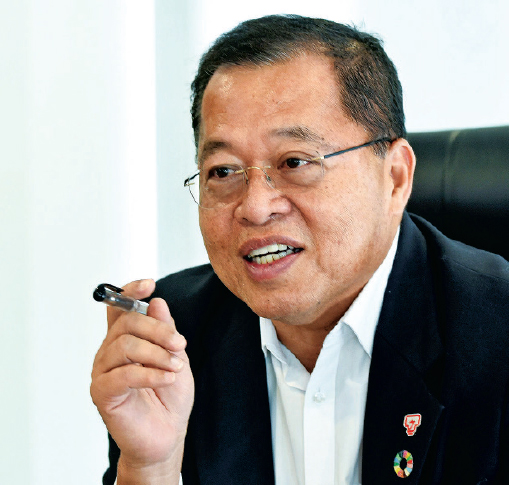
This article first appeared in Digital Edge, The Edge Malaysia Weekly on July 24, 2023 - July 30, 2023
Without a good and consistent electricity supply, making electric vehicle (EV) usage mainstream will remain a pipe dream. Thus, as Malaysia’s biggest electricity provider, Tenaga Nasional Bhd (Tenaga) plays a huge role in determining whether that future can be realised.
The utility has been taking steps in this direction. For one, it founded the Zero Emission Vehicle Association (ZEVA) with industry players, including those from the automotive industry and vehicle importers, to lobby for an EV-friendly policy with the government.
It also pledged to help the government achieve its target of having 10,000 EV chargers by 2025, whether by facilitating Charge Point Operators (CPOs) or building their own EV chargers under TNB Electron.
“EV adoption in this country is relatively low, with some signs of positive adoption. It is important to build EV infrastructure to remove range anxiety due to the infancy stage of adoption in this country,” says Tenaga president and CEO Datuk Indera Baharin.
“Through collaborative efforts from all players, such as EV manufacturers and operators, to promote EV adoption, the number of EVs shall grow, enabling the infrastructure investment across the nation to reach the required profitability through economies of scale.”
Currently, ZEVA has 55 members, including BMW Group Malaysia, Bermaz Auto Bhd, GreenEV Charge Sdn Bhd, Sarawak Energy Bhd and Solarvest Energy Bhd.
According to Minister of Natural Resources, Environment and Climate Change Nik Nazmi Nik Ahmad in February, there were more than 10,000 registered EVs in the country and 900 public EV chargers. Clearly, much more must be done to reach the government’s target. When there are more EV chargers, potential customers’ range anxiety will be reduced. Subsequently, this will boost the take-up of EVs.
To drive the needed system-wide changes, ZEVA will be focusing on initiatives like establishing standardised procedures and policies with the government to deploy EVs and providing technical and commercial input, says Baharin. ZEVA will also collaborate with relevant authorities like the Fire and Rescue Department of Malaysia and the Ministry of Housing and Local Government to ensure compliance with safety regulations.
Most of the EV charging will likely be done at home, with additional charging done in hotels, offices, shopping malls and rest and relaxation (R&R) stations along highways.
“ZEVA’s research shows that 76% of residential units in Kuala Lumpur are located within high-rise buildings. As a result, EV charging will predominantly be made available in basements and multi-level car parks,” says Baharin.
“In the upcoming months, ZEVA will proactively provide the necessary input to determine the necessary approach for deploying the EV chargers at these premises, with the aim of facilitating widespread EV adoption.”
Adding chargers to the network
There are already many CPOs in the market that are setting up EV chargers in malls, offices and petrol stations. Tenaga has been facilitating these CPOs by ensuring that electricity supply is provided quickly and safely. On the other hand, it has committed RM90 million over three years (2022–2024) to roll out its own EV chargers.
The installation plan includes Alternating Current (AC) chargers at 29 locations and Direct Current (DC) fast chargers in 37 locations. So far, it has installed three DC chargers at R&Rs along the PLUS highway: R&R Tapah Northbound (100kW), R&R Ayer Keroh Northbound (90kW) and R&R Paka Northbound (90kW).
“In the future, we aim to deploy an additional 120 chargers, totalling 240 charging points across Peninsular Malaysia’s highways and trunk roads. AC chargers have a longer charging duration and are well suited for locations where cars are stationary or parked for longer periods, such as offices or shopping malls,” says Baharin. DC chargers, meanwhile, would be ideal for R&R or petrol stations.
“For most EVs, it takes approximately 20 to 30 minutes to achieve an 80% charge. We encourage users to charge up to 80% to protect the battery lifespan,” says Baharin.
The cost of charging EVs based on current rates offered by CPOs is about 11.4% to 28.3% lower than filling an internal combustion engine (ICE) vehicle with RON95, he adds. According to TNB’s website, the cost for its three DC charging points currently ranges from RM2.20/min to RM2.35/min.
“Transitioning from ICE vehicles to EVs has the potential to reduce carbon emissions by at least 23% based on the current electricity generation methods,” he says.
Tenaga also introduced the GO TO-U app to allow EV drivers to search for and book charging stations through their phones.
Aside from facilitating CPOs and building EV chargers itself, Tenaga has been collaborating with corporations to electrify their fleets. The memorandums of understanding that the company has signed include one with DHL Express Malaysia to install EV charging stations at the delivery company’s service centre and delivery routes to support DHL’s rollout of EV vans and bikes.
Another collaboration is with vehicle sharing network Socar Malaysia, which will share data on vehicle usage and travel behaviour with TNB to identify strategic locations for EV chargers.
“TNB actively promotes awareness to encourage public users to embrace the adoption of battery EVs. We collaborate with various partners through ZEVA by bringing together all industry players to drive the electrification of mobility, thereby contributing to the country’s goal of achieving net zero emissions,” says Baharin.
Save by subscribing to us for your print and/or digital copy.
P/S: The Edge is also available on Apple's App Store and Android's Google Play.

